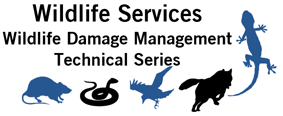United States Department of Agriculture: Animal and Plant Health Inspection Service

Wildlife Damage Management Technical Series
Date of this Version
3-2023
Document Type
Article
Citation
Witmer, G., J. Grant and K. Cross. 2023. Prairie Dogs. Wildlife Damage Management Technical Series. USDA, APHIS, WS National Wildlife Research Center. Fort Collins, Colorado. 16p.
Abstract
Prairie dogs (Cynomys spp.) occur throughout the prairie states of middle North America from Mexico northward into Canada. They occupy a variety of habitats from prairies to high mountain valleys and sage brush-dominated deserts. The most common species is the black-tailed prairie dog (Cynomys ludovicianus; Figure 1). Prairie dogs are considered a “keystone species.” They provide habitat for many other native, grassland species. Prairie dogs live in colonies or “towns” that can span hundreds to thousands of acres. Depending on the species, their presence is evident by their burrow system. Despite the many ecosystem benefits prairie dogs provide by modifying grasslands, they also create conflicts with people when their activities cause damage. This damage can occur on agricultural lands, as well as in urban and suburban settings.
Utah and Mexican prairie dogs are listed as threatened or endangered species and are protected by law. Contact the State wildlife agency and/or the U.S. Fish and Wildlife Service (USFWS) for specific requirements and options regarding damage management methods for these species. If a prairie dog colony contains endangered black-footed ferrets (Mustela nigripes), options for prairie dog control are more restricted. Responsible and professional reduction or elimination of wildlife damage is the goal of wildlife damage management practitioners. This is best accomplished through an integrated approach. No single method is effective in every situation, and success is optimized when damage management is initiated early, consistently, and adaptively using a variety of methods. Because the legality of different methods varies by State, consult local laws and regulations prior to implementing any method. In addition, regulations may require that a survey be conducted to determine if threatened or endangered species are present.
Included in
Behavior and Ethology Commons, Biodiversity Commons, Other Animal Sciences Commons, Other Ecology and Evolutionary Biology Commons, Population Biology Commons, Terrestrial and Aquatic Ecology Commons


Comments
U.S. government work